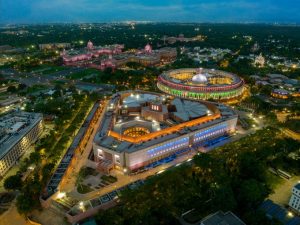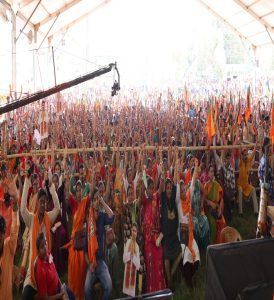Agriculture is both problem & solution for climate change

Photo credit Twitter Princy Gupta
By Pradeep Kumar Panda
Bhubaneswar, April 13: Indian agriculture is missing the state of the art technology and modern method of farming. Advance world is moving towards precision farming using sensors and other scientific tools for exact practices and application of inputs. It saves costs, reduce environmental effect and yield more and better quality produce.
We still continue to use flood method of irrigation, broadcasting fertilisers, and indiscriminately spraying chemicals whereas advance countries are shifting towards use of sensor based application of inputs based on actual requirement of plant. Application of advance science at farm level requires skill, knowledge, investments and improvement in human capital in farming.
Indian agriculture continues to be dominated by low-tech farm practices, low level of mechanization and relatively lower yielding cultivars compared to global level. Upgrading farming from low tech to high-tech (green house cultivation, poly houses, tissue culture, precision farming) will reduce average cost, raise farmers income and address some scale disabilities.
Green House gases emitted from agricultural activities are generally not visible. The emission results from application of organic and inorganic inputs to the soil for crop production, decomposition of biomass and dead plant residues, crop production, plant respiration, livestock rearing, enteric fermentation in ruminants, manure handling, and burning of crop residues.
Agriculture is responsible for about 17 per cent of GHG emission in India which is almost same as its share in GDP. Three-fourth of this is due to methane produced from rice cultivation and livestock and the remaining 26 per cent comes from nitrous oxide emitted from fertiliser. The share of agriculture in total GHG emissions will increase significantly if burning of crop residue, which is now spreading to all states, is taken into account.
Air, water and land are the three pillars of sustainability. According to official sources 80-90 per cent of total water used in the country is used in agriculture sector. Still more than 50 per cent area under cultivation is without irrigation. Because of common practice of flood irrigation, water use efficiency in the country is around 30-35 per cent.
India use 2-3 times the water used to produce 1 tonne of food in major agricultural countries. Water intensive crops are being grown in low rainfall areas and water intensive practices are spreading. Free or subsidised power for agriculture and free water for irrigation encourage excessive use of water and do not leave any incentive for water saving.
As a consequence, groundwater resources are getting depleted in almost all the states. Data from monitoring wells for groundwater level reported by Central Ground Water Board show a big decline in area with groundwater depth below 3 metres and 3-5 metres and a big increase in area with groundwater depth exceeding 10 metres below ground level between 1998 and 2018.
Further, these changes are spread over all regions of the country though severity of change differs across regions. In order to put a check on further overexploitation of water resources the country should create policy environment that leads to crop pattern and practices consistent with the natural resource endowment in various agro ecological zones of the country. Further, without improving efficiency of water use in agriculture through modern method of irrigation (drip, sprinkler, sensors) the country cannot address stress on water use and meet future water requirement.
Almost half of the land in India is for agriculture uses (arable land). Therefore, the way agriculture is done, determines quality of soil and land resources. Very less area is available for ecological activities and functions. Meeting land requirement for non-agricultural uses and addressing sustainable land use necessitate higher productivity in agriculture.
It is evident from above that agriculture is central to climate change and clean air, and sustainable use of land and water. Agriculture is both part of the problem and part of the solution to climate change and sustainability. We must seize every opportunity to shift away from inefficient farm practices, towards long-term sustainability, efficiency and resilience.








